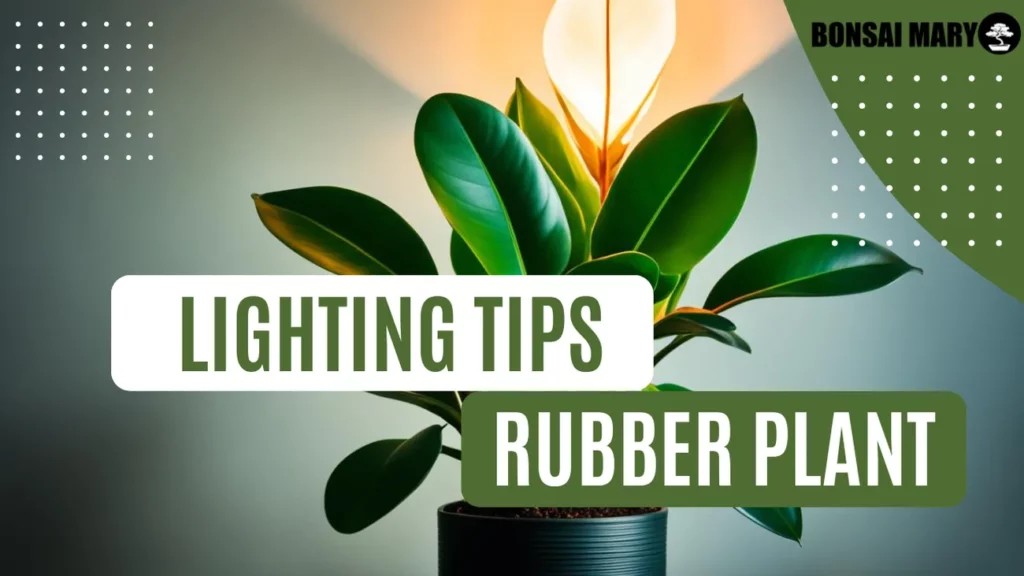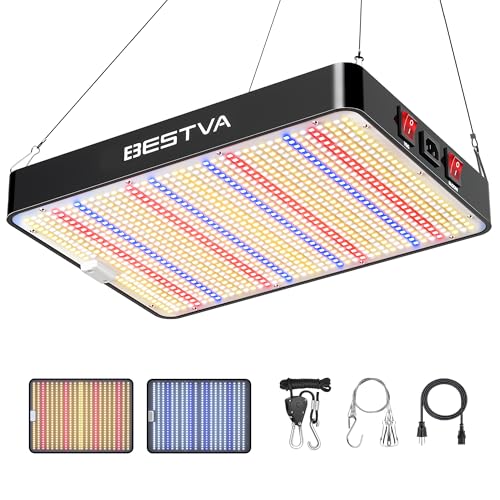Place your Rubber Plant in bright, indirect sunlight and avoid direct sun exposure to prevent leaf scorching.
Discover essential lighting techniques for your Rubber Plant, ensuring it receives the perfect balance of bright, indirect light. This succinct guide covers the ideal positioning and the use of artificial lighting to enhance growth, making it indispensable for both new and experienced plant enthusiasts aiming to foster a lush, vibrant Rubber Plant.
Understanding Rubber Plant Lighting Needs

Before we delve into the specific tips for rubber plant lighting, it’s essential to understand the lighting needs of these plants. Rubber plants have specific preferences when it comes to light exposure, and meeting these requirements is crucial for their overall health and growth.
Rubber plants prefer bright, indirect light: While they can tolerate moderate levels of shade, providing them with bright, indirect light is ideal.
This means placing them in a location where they receive filtered sunlight or ambient light without direct exposure to intense rays.
By striking the right balance between light and shade, you can ensure that your rubber plant thrives and flourishes. Too much direct sunlight can scorch the leaves and cause damage, while insufficient light can result in weak or leggy growth.
Choosing the Right Location

When it comes to optimizing the lighting conditions for your rubber plant, selecting the right location is key. Finding a spot where your plant can receive bright, indirect light for most of the day will ensure its healthy growth.
Avoid placing your rubber plant in direct sunlight, as this can lead to leaf scorching and damage.
To provide the perfect lighting conditions, consider placing your rubber plant near a north or east-facing window. These orientations typically receive gentle, indirect light throughout the day.
This positioning will help mimic the plant’s natural habitat and promote optimal growth.
Assessing Natural Light Levels

Before making any lighting adjustments, it’s essential to assess the natural light levels in your chosen location. By understanding the natural light available, you can determine if it meets the ideal requirements for your rubber plant’s growth and well-being.
Start by observing how the sunlight filters into the room throughout the day. Take note of the intensity and duration of sunlight in different areas.
Is there a spot where the light is consistently bright and indirect? This would be an excellent location for your rubber plant.
No products found.
You can also consider using a light meter to measure the light levels in your space. This device will give you precise data on the intensity of natural light in different areas. With this information, you can make informed decisions about where to place your rubber plant.
Supplementing with Artificial Light

If your rubber plant isn’t receiving adequate natural light, you can supplement its lighting needs by incorporating artificial light sources. This ensures that your plant receives the required light spectrum for optimal growth.
No products found.
LED grow lights and fluorescent lights with a color temperature of 6500K are excellent choices for providing supplementary light to your rubber plant. These lights mimic natural sunlight and promote healthy photosynthesis, supporting vigorous growth and vibrant foliage.
No products found.
When selecting artificial lights, consider the wattage and coverage area to ensure proper illumination. Aim to position the lights about 12-18 inches above the rubber plant’s foliage, maintaining an optimal distance for effective light absorption.
Creating a Lighting Schedule
To maintain consistency, it’s recommended to use a timer for your artificial lights. This allows you to schedule the lighting periods based on your plant’s requirements, without the need for manual adjustments each day.
Ensure that the artificial lights are turned on and off at the same time every day, mimicking a natural day-night cycle. This regularity provides stability for your rubber plant and avoids any abrupt changes or fluctuations in the lighting conditions.
Proper Light Duration

When it comes to providing the best lighting conditions for your rubber plant, proper light duration is essential for its overall health and well-being. The duration of light exposure directly affects the plant’s growth and development.
For optimal results, aim to provide your rubber plant with around 12-14 hours of light per day. This duration allows the plant to undergo photosynthesis, the process that converts light energy into chemical energy, promoting healthy growth.
However, it’s crucial to avoid sudden changes in light duration, as this can cause stress to the plant. Gradual adjustments are recommended to ensure a smooth transition.
One way to maintain a consistent and reliable light schedule is by using a timer for your artificial lights. This handy tool can automatically turn the lights on and off at specific times, ensuring that your rubber plant receives the adequate light duration it needs.
Monitoring Light Intensity

Monitoring the light intensity for your rubber plant is crucial for maintaining its health and promoting optimal growth. While rubber plants are known for their tolerance to a range of light intensities, it’s important to avoid extremes to prevent any light-related stress.
Here are some key points to consider when monitoring the light intensity for your rubber plant:
- Too much light can lead to leaf burn, causing the leaves to develop unsightly brown spots. It’s important to ensure that your rubber plant is not exposed to direct sunlight for prolonged periods, especially during the peak hours of the day.
- On the other hand, too little light can result in leggy growth, where the stem lengthens excessively between leaves. This can make your rubber plant appear less compact and bushy. To avoid this, make sure your plant receives adequate light throughout the day.
- Regularly observe your rubber plant for any signs of light stress, such as discolored or wilting leaves. If you notice any changes in leaf color or texture, it could be an indication that the light intensity needs to be adjusted.
Rotating the Plant

To ensure balanced growth and optimize lighting conditions for your rubber plant, it is important to periodically rotate the plant. This simple practice prevents the plant from leaning towards the light source and promotes even foliage development.
Aiming to rotate your rubber plant every few weeks will ensure that all sides of the plant receive uniform light exposure. This helps to prevent lopsided growth and encourages the plant to grow evenly.
By regularly rotating your rubber plant, you can maintain its aesthetic appeal and ensure that all leaves receive adequate light for optimal photosynthesis.
Cleaning the Leaves

Dust and debris can accumulate on rubber plant leaves over time, reducing their ability to absorb light. Regularly wiping the leaves is an essential part of maintaining their health and maximizing light absorption.
To clean the leaves, gently dampen a soft cloth with water. Starting from the base of the leaf, gently wipe the surface, removing any dust or dirt. Be sure to wipe both the top and bottom surfaces of the leaves.
- Use a light touch to avoid damaging the leaves.
- Pay extra attention to the leaf crevices and undersides, as these areas tend to accumulate more dust.
- Avoid using any harsh chemicals or cleaning agents, as they can harm the plant.
Monitoring Plant Response
One of the key aspects of ensuring the optimal lighting conditions for your rubber plant is to monitor its response to the current lighting setup.
By closely observing your plant’s reaction, you can identify any signs of stress or imbalance and make necessary adjustments to promote its health and growth.
Keep an eye out for potential indications that your rubber plant may not be receiving the ideal lighting it requires. Leaf discoloration, such as yellowing or browning, can be a sign of light stress.
Additionally, if you notice stunted growth or the plant leaning towards the light source excessively, it may indicate that the current lighting conditions are not suitable.
To effectively monitor your rubber plant’s response, regularly check its leaves for any changes in color or texture. Take note of its overall growth rate and compare it to the expected growth patterns.
By doing so, you’ll have a better understanding of how your plant is adapting to the current lighting and whether any adjustments are necessary.
As you observe and analyze your rubber plant’s response to lighting, remember to be flexible in your approach. Every plant is unique, and finding the perfect lighting balance may require some trial and error.
By paying attention to your plant’s needs and making adjustments accordingly, you’ll be able to create an optimal lighting environment that supports its overall well-being.
- Regularly check the leaves for any signs of stress, such as discoloration or wilting.
- Observe the growth rate and compare it to the expected patterns.
- Be flexible and adjust the lighting conditions as needed.
Troubleshooting Common Issues
If you’re experiencing any issues with your rubber plant’s lighting, don’t worry! We’ve got you covered with some troubleshooting solutions.
Below, we’ll address common problems and provide tips on how to resolve them, ensuring your rubber plant stays healthy and happy.
1. Too Much Light: If your rubber plant is exposed to excessive direct sunlight or bright artificial light, it can lead to leaf burn and discoloration. Consider moving the plant to a spot with slightly less intense light, or provide some shade using curtains or blinds.
2. Too Little Light: Insufficient light can cause your rubber plant to become leggy and weak. If you notice elongated stems and sparse foliage, try relocating the plant to a brighter area.
Alternatively, you can supplement with artificial lights to provide the necessary light spectrum.
3. Inconsistent Light: Sudden changes in light duration or intensity can stress the rubber plant. Make sure to maintain a consistent lighting schedule and avoid moving the plant around frequently.
Remember to use a timer for artificial lights to ensure a steady light source.
4. Improper Light Duration: Over or underexposure to light can hinder the growth of your rubber plant. Aim for around 12-14 hours of light per day, allowing for a rest period at night.
Adjust the duration based on your plant’s response and consider using a timer for convenience.
5. Monitor Heat Exposure: Rubber plants are sensitive to temperature, and excessive heat can harm their leaves. Keep your plant away from heat sources such as radiators or heating vents and ensure proper air circulation.
Maintaining a temperature between 60-75°F (15-24°C) is ideal.
Expert Tips for Advanced Rubber Plant Lighting
If you’re looking to elevate your rubber plant’s lighting game, these expert tips and techniques are just what you need. By implementing advanced strategies, you can optimize the lighting conditions for your rubber plant and ensure its growth and vitality.
One technique to consider is using specialized lighting setups. Supplement your natural light with full-spectrum grow lights that mimic the sun’s rays. These lights provide a well-rounded spectrum of light that promotes photosynthesis and overall plant health.
Experimenting with different light spectrums is another way to enhance your rubber plant’s growth. Try using blue light during the vegetative stage to encourage leaf development and switch to red light during the flowering stage to promote blooming.
Adjusting the light spectrum at different stages can optimize the plant’s physiological processes.
Don’t forget to regularly reassess and fine-tune your lighting setup. Keep an eye on your plant’s response to the changes you’ve made. Monitor its growth rate, leaf color, and overall appearance.
This observation will help you determine if any further adjustments are needed to achieve the best possible lighting conditions.







I have taken a branch/stem from a rubber Tree (I live in Southern Florida where they are large 🌴) and are rooting at the moment it’s outdoors- what do I need to consider when I transition it for indoors?
The most important aspects when transitioning a rubber tree from outdoors to indoors include gradual acclimatization to indoor conditions over 1-2 weeks, ensuring it receives bright, indirect light indoors, and maintaining moderate humidity levels while allowing the soil to slightly dry out between waterings.